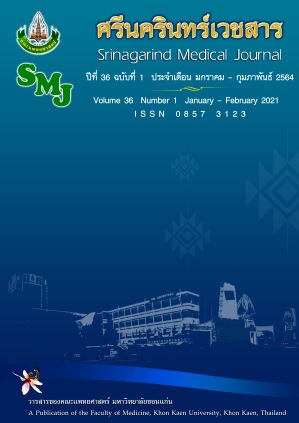The Impact of Smartphone Texting on Gait Speed in Adolescent
Abstract
ผลกระทบของการใช้สมาร์ทโฟนในการพิมพ์ข้อความโต้ตอบต่อความเร็วการเดินในวัยรุ่น
ณิชาภา พาราศิลป์*, เกวลี สีหราช
สาขาวิชากายภาพบำบัด คณะสหเวชศาสตร์ มหาวิทยาลัยพะเยา
หลักการและวัตถุประสงค์: วัยรุ่นให้ความสนใจกับการใช้โซเชียลมิเดียผ่านสมาร์ทโฟน ทั้งการส่งข้อความโต้ตอบ การแบ่งปันภาพถ่าย หรือการสนทนา โดยใช้สมาร์ทโฟนทุกที่ เช่น ห้องนอน ห้องน้ำ การเดินทางสาธารณะ หรือ ขณะเดิน เป็นต้น ถึงแม้ว่าการใช้โซเชียลมิเดียผ่านสมาร์ทโฟนจะมีประโยชน์แต่ขณะเดียวกันก็ส่งผลกระทบต่อสุขภาพเช่นกัน การใช้สมาร์ทโฟนขณะเดินอาจจะทำให้เกิดการเปลี่ยนแปลงความเร็วในการเดินได้ วัตถุประสงค์ของการศึกษานี้คือเพื่อเปรียบเทียบความเร็วในการเดินระหว่างใช้และไม่ใช้สมาร์ทโฟนขณะเดินในกลุ่มวัยรุ่นที่เสพติดการใช้อินเตอร์เนต
วิธีการศึกษา: อาสาสมัครจำนวน 25 ราย ที่มีอายุระหว่าง 12-16 ปี ร่วมกับการเสพติดอินเตอร์เนตระดับปานกลาง ประเมินด้วยแบบประเมินพฤติกรรมการเสพติดอินเตอร์เนต (IADQ) ได้รับการเชิญเข้าร่วมการศึกษานี้ อาสาสมัครทุกรายได้รับการประเมินความเร็วในการเดินด้วยการเดิน 10 เมตรใน 2 เงื่อนไข เงื่อนไขที่ 1 อาสาสมัครได้รับคำแนะนำให้เดินโดยไม่ใช้สมาร์ทโฟน เงื่อนไขที่ 2 อาสาสมัครต้องส่งข้อความโต้ตอบโดยใช้สมาร์ทโฟนขณะเดิน ข้อมูลความเร็วในการเดินถูกวิเคคราะห์ด้วยสถิติ Independent-sample T test โดยกำหนดระดับนัยสำคัญทางสถิติที่ p < 0.05
ผลการศึกษา: อาสาสมัครที่ใช้สมาร์ทโฟนพิมพ์ข้อความโต้ตอบขณะเดินใช้เวลาในการเดินเพิ่มขึ้นอย่างมีนัยสำคัญทางสถิติ ทั้งความเร็วแบบปกติ (เพิ่มขึ้น 0.12 เมตร/วินาที, p < 0.000) และ ความเร็ซสูงสุด (เพิ่มขึ้น 0.3 เมตร/วินาที, p < 0.000)
สรุป: การส่งข้อความโต้ตอบโดยใช้สมาร์ทโฟนขณะเดินลดความเร็วในการเดินในกลุ่มวัยรุ่นที่เสพติดอินเตอร์เนตระดับปานกลาง ซึ่งเพิ่มความเสี่ยงต่อการล้มขณะเดินได้ อย่างไรการศึกษาในอนาตตควรศึกษาในกลุ่มวัยรุ่นที่เสพติดอินเตอร์เนตระดับระดับอื่นๆ ร่วมด้วย
คำสำคัญ: สมาร์ทโฟน; ความเร็วในการเดิน; การพิมพ์ข้อความโต้ตอบ
Background and Objective: The adolescents pay attention to social media using several applications on a smartphone and are online and on their phones, texting, sharing, talking, you name it, everywhere, i.e., bedroom, bathroom, public transport or while walking etc., Even though, social media on a smartphone is a useful technology, but it also effects on physical health. Smartphone use during walking may be change gait speed. The purpose of this study was to compared walking speed during walking with use and no use smartphone in internet addict adolescent.
Methods: Twenty-five subjects aged 12-16 years old with moderate internet addict level using the internet addiction diagnostic questionnaire (IADQ) were invited in this study. All subjects were evaluated the walking speed using 10-metre walk test in two condition. Frist condition, subjects were instructed to walking without smartphone use. Second condition, subject will be texting using smartphone during their walking. The mean walking speed data was analyzed by Independent-sample T test and statistical significance was set at p < 0.05.
Results: Subjects who walking with texting using smartphone showed significant increasing in both normal comfortable walking speed (0.12 m/s increasing, p < 0.000) and maximum walking speed (0.3 m/s increasing, respectively).
Conclusions: Texting using smartphone during walking reduce gait speed in moderate internet addict adolescent. This may increase the greater risk of falls. However, future studied should be investigate in other level of internet addict adolescent.
Keyword: Smartphone; Waling Speed; Texting


